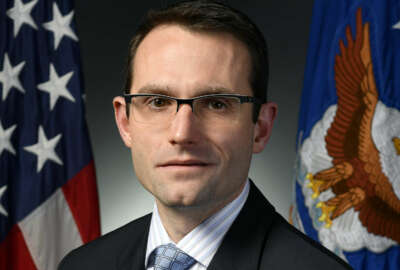Army sets stage for broader adoption of digital engineering
Gabe Camarillo, the undersecretary of the Army, said the new digital engineering policy will bring the service more in-line with industry best practices.
The Army has seen enough from its six pathfinders using digital engineering tools and techniques that it’s ready to go all in on.
A new memo, which Gabe Camarillo, the undersecretary of the Army, signed Tuesday, sets the stage for broader adoption of digital engineering capabilities and practices.

“We are looking to benefit from that utilization of digital engineering tools to be able to help establish the right processes in the Army, the right training and really how do we adopt adapt our institutional approach to be able to accommodate more digital engineering,” Camarillo said in a speech during the AFCEA NoVa Enterprise IT day. “The commercial automotive industry does this already. The commercial aircraft industry obviously has been doing this for a really long time. And we’ve actually taken some significant steps in this area….We’ve got a toehold, if you will, in the Army in those areas. We want to expand on it and really accelerate some of the efforts in those three areas, and then the goal is we would expand it out.”
Camarillo said the Army has been using digital engineering tools and capabilities in three areas, ground vehicles, aviation and sensors, which the policy also calls out.
The policy outlines four lines of effort. The first is to create digital engineering focus areas as centers of gravity to be able to begin to accelerate the adoption of digital engineering tools.
“The reason why we’re taking this approach on this first LOE is we recognize that you know, the way DE is employed varies or its varied based on the commodity area that you’re talking about. It’s very mature in a lot of these domains,” he said.
Army taking commodity-focused approach
The Army has applied DE tools and capabilities to the XM 30 Bradley Infantry Combat Vehicle replacement program, the Future Long-Range Assault Aircraft effort and the M113 Armored Personnel Carrier. All three of these pathfinders are in sustainment funding mode.
The second line of effort is around shaping interoperability and standards for implementation. Camarillo said the Army doesn’t want to just pick one or two tools, but use a more commodity-focused approach.
Camarillo added the Army needs to understand the standards around interoperability or cybersecurity, for example, and then be more consumers of the market versus dependent on one tool or a set of tools.
“If we’re going to be consumers in this market, we have to articulate what we need to industry. I think over time, the software will evolve to accommodate us,” he said. “We’re already seeing a lot of great dialogue with multiple vendors along this side. I think part of it is also standardizing our contracts approach so that we know what we’re asking for and that we do so in a in a rational, consistent way.”
Third line of effort is to continue to test out these concepts through Pathfinder programs.
“These programs range the lifecycle of a weapon system from early design, like I mentioned with the XM 30, all the way to some programs that are well under sustainment as legacy programs to be able to identify how we can utilize them. The goal here is to just think about how do you change our processes? So if you’re doing a preliminary design review of a system in development, or if you’re doing the need to identify cost driving parts for a legacy system? How do you get after that by looking at some of these Pathfinder programs?” he said. “The fourth [LOE] is workforce, developing our workforce, ensuring that they have the right training. And then of course, looking at opportunities to train with industry, particularly with those partners that have really evolved digital engineering capabilities and practices, and doing the right kinds of talent exchanges with industry to be able to permeate some of the best practices over to the Army.”
Looking for workforce training
As with any new policy or new initiative, the workforce tends to be the biggest challenge. While digital engineering isn’t necessarily a brand new concept for the Army, it will need to find some of those champions and experts and then start to spread the knowledge.
Camarillo said the opportunities to learn from industry experts who have been using digital engineering for some time and have Army employees bring back some the best practices from these vendors.
“We have some pretty robust training with industry programs and private party talent exchanges. We’re looking to expand those to include some of these digital engineering companies that have pretty robust practices in place,” he said.
The policy also calls on the Army to develop recipes and guidelines as well as creating standard contract language and contract data requirements lists to ensure consistency in the products vendors deliver to the Army.
The private sector has been using digital engineering for many years. Simply put, digital engineering relies on data, advanced technologies such as simulation and modeling and traditional systems engineering practices to create digital models instead of the more traditional paper based models. These virtual representations can change over time as the needs of the organization or technology changes and they make it easier for the developers to understand a host of challenges ranging from cost to sustainment to how this system will work with other systems.
Digital engineering isn’t new
Digital engineering is not a new concept for DoD. The Pentagon issued a digital engineering strategy in 2018. That strategy outlines five elements necessary for the digital engineering ecosystem including, formalizing the development and use of models, providing an authoritative source of truth, incorporating technological innovation, establishing a supporting infrastructure and environment, and transforming the culture and workforce to adopt and support digital engineering.
The Army’s policy is building on the work done by DoD as well as other services over the last few years.
Camarillo said the policy will help the Army in its race to catch up with the private sector.
He said the entire effort is about accelerating the adoption of these tools, after the Army’s six pathfinders showed the potential and value of digital engineering.
“The benefits to us is it’s going to be the way that we do business in terms of developing warfighting capabilities in the future,” he said. “It enables our ability to identify requirements tradeoffs earlier in the process, to plan more adequately for sustainment of both hardware and software. It identifies cost drivers in the operation of weapon systems in the future. And it helps us to identify and mitigate technical risks through more robust modeling and simulation and the development of digital twins.”
Copyright © 2025 Federal News Network. All rights reserved. This website is not intended for users located within the European Economic Area.
Jason Miller is executive editor of Federal News Network and directs news coverage on the people, policy and programs of the federal government.
Follow @jmillerWFED






